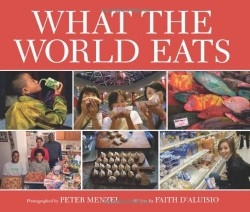What The World Eats
Every week, families around planet Earth gather for meals at tables, in tents, or on dirt-packed floors, but what they eat depends on where in the world they live. The authors of this book set out to document those weekly meals by visiting twenty-four families in twenty-one countries, from Australia to Mongolia.
Each family vignette features a portrait of the household members surrounded by a typical week’s worth of food, a detailed grocery list with costs, and a few family recipes. Essays discussing how and where the families procure their food, as well as their eating and cooking habits, accompany the portraits. There are also photos of the families at home and in the community and thought-provoking photo essays of food-related topics such as kitchens and fast food.
Seeing, at a glance, a whole week’s supply of food artfully arranged in a kitchen is an eye-opening foray into cultural differences in family diets. The sheer variety and quantity of foods is most evident in countries like the U.S., France, and Japan, and in stark contrast to a family of six in a refugee camp in Chad; the Aboubakars from the Darfur province of Sudan sit cross-legged on a rug in front of their tent with only three bags of grain and legumes, one bottle of vegetable oil, and several tiny bags of items such as salt, chili peppers, and garlic.
Readers will see a fascinating snapshot of other marked differences in food consumption. For example, the photos reveal that non-Western families such as those in China, Ecuador, Guatemala, and India dine on much larger proportions of fruits and vegetables than those in Great Britain and Greenland. It’s interesting to note the amount of packaged and processed foodstuffs consumed in industrialized and emerging countries versus the colorful piles of fresh greens, citrus fruits, tomatoes, and bulging sacks of potatoes and rice in developing nations.
Author Faith D’Aluisio and photographer Peter Menzel, a husband and wife team, collaborated on other books including Man Eating Bugs and Women in the Material World.
Most Westerners take food for granted, but—as the authors point out—for those in developing countries, the margin for survival is only as wide as a noodle. This book is especially timely given recent news reports of an impending world food crisis, and it will provoke young people to contemplate their own family menu compared to the rest of the world.
Reviewed by
Luise Bolleber
Disclosure: This article is not an endorsement, but a review. The publisher of this book provided free copies of the book to have their book reviewed by a professional reviewer. No fee was paid by the publisher for this review. Foreword Reviews only recommends books that we love. Foreword Magazine, Inc. is disclosing this in accordance with the Federal Trade Commission’s 16 CFR, Part 255.

